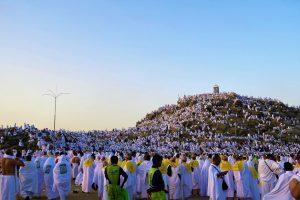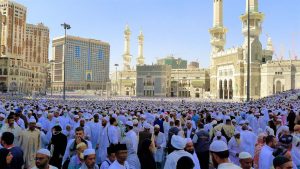Mizane.info publishes a new chronicle of the imam and writer Ahmad Kante in which he briefly reviews the origin of the different stages of the pilgrimage (hajj) in the Abrahamic journey.
There is a plethora of books and audio documents on the ritual of Hajj (pilgrimage) which is a very good thing. Indeed, Islamic ritual practices are revealed, that is to say that in this matter, the Muslim limits himself to fulfilling the prescriptions established in the Koran and the Sunnah without changing anything: obedience and conformity.
Obedience is a proof of fidelity and trust in God, which excludes the option “non-practicing Muslim” while conformity consists of respecting the ritual as revealed.
In the lines that follow, the goal is to focus on some aspects of the “inner” dimension of the Hajj and on the other hand, to offer a quick reflection on the articulation of the Mosque of Mecca and that of Jerusalem.
Hajj: the sanctification of the pilgrim
Thus, with regard to the Hajj, after having completed the construction of the Kaaba, Ibrâhîm and Ismâ’îl (peace be upon them) ask God (Allah) the Most High to indicate the ritual to be observed. (Quran 2: 128) On his side, the Prophet (PBDSL) will say: “Take from me your ritual practices”
But, in addition to and not in opposition to the necessary ritual given to us and through which God reveals His wisdom and His mercy, it is decisive not to neglect the interior dimension of any act of worship so that it does not end up reduced to routine gestures and remarks devoid of the spirit that should animate them.
We know that scholars like Ghazali have insisted a lot on this aspect of “rûh” interiority and “khuchû'” fervor which are inseparable from the ritual and which guarantees their spiritual flavor. In this context, it is useful to briefly recall these dimensions of meaning in the Hajj ritual.
The moment of “ihram” (sacredness) marks the intention of the pilgrim to put himself in a sanctified time where he withdraws in some way from the world here below while being there physically. From this moment on, he does not say or do anything that could distance him from God in the sense of His approval: sexual relations, arguments, cutting his hair, nails, etc. are forbidden to him. The humble garment reminds him of the vanity of appearance and superfluity.
The “Tawâf” (rotation) around the Kaaba, 7 times, starting from the black stone and counter-clockwise operates as an exercise that teaches him to stay in close proximity to God.
From Safa to Marwa, the Hajar race
The “Talbiya”, declaimed until breathless, contains “given” expressions which all refer to the proclamation of the Oneness and absolute sovereignty of God, that He is the only one who deserves Praise and that ‘He is the One and He alone who enables us to benefit from His inestimable benefits.
The half-course between the mounds of “Safa” and “Marwa” recalls the ordeal to which this exemplary believer who was Hâjar (Agar of the Bible) was subjected. In the middle of the desert with an infant, Ishmael (peace be upon him), she does what she can to find water while keeping complete trust in Allah (SWT): faith is not fatalism.
Nothing in the ritual of the pilgrimage is dissociable from the dignity in the trial closely associated with hope in God. And the pillar of the end of the pilgrimage is accomplished by the stationing of the pilgrim in the space dedicated to Arafat. It is the moment of invocations and repentance which prefigure the day of the last judgment.
Without forgetting the throwing of pebbles “jamarât” which symbolizes the fight of the faithful against the temptations of Satan who seeks to prevent him from doing what can bring him closer to God and free him from the prison grip of the tinsel of this world here- low, of his evil inclinations and of the one whom the Koran called the deceiver “al gharûr”, Satan. The pilgrim who sincerely and beautifully combines the spirit and the ritual of Hajj can hope to return home, as the known hadith says, “cleansed” of his sins as if he had just been born.
In addition to these brief lines on the inner dimension of the Hajj, we would like to add another on the articulations between “al masjididul harâm” and “al masjidul aqsâ”.
These two Mosques are mentioned together, and it is not by chance, in the first verse of sura 17 which bears two names: “surat al isrâ” (surat the night journey) and “surat banû isrâ-îl” (surat sons of Israel): Glory to Him who made His servant travel[1] at night, the Sacred Mosque[2] to the farthest mosque[3] which We have blessed the surrounding area(s), in order to make him see some of Our signs. He is truly the One who hears and sees everything”. (Quran 17:1).
Abraham’s trial and trust in God
The question of who was the first to build the Kaaba is not decided among the ulama. For some of them, it is the angels who built this first House of God on earth, for others, it is rather Adam and for still others, it is Abraham (peace be upon them).
In any case, by the mention which is made of it in the Koran, it is to Abraham that God showed the location of the House where he will build it with the help of Ishmael, the son he had with Hajar. (Quran 14:37), (Quran 22:26).
These verses seem to indicate that the Sacred House was once built in this place of Mecca. After having installed Hâjar and his infant in the desert which will become Mecca, Abraham leaves while invoking God in pious terms and heralding a radiant future for his lineage which will pass through his eldest son Ishmael (peace be upon them) and for this extremely arid place.
Abraham leaves the land of Canaan to install his wife Hâjar and his infant, Ishmael (peace be upon them), in the middle of the desert with the only attitude, that of the exemplary believer who obeys and who trusts while asking God for the best for his family. under conditions where only His intervention could be beneficial for the latter (Quran 14: 37).
When Abraham returns to the land of Canaan, God intervenes so that Hâjar and her infant are miraculously safe and sound and are finally adopted by the Arab tribe of “jurhum”.
Abraham will return a few years later to notably be confronted with the test of sacrifice. His son Ishmael (peace be upon him), shows unshakeable faith and encourages him to accomplish what he saw in a dream (Qur’an 37: 102-106). Thereafter, Abraham receives with his son Ishmael (peace on them), order to purify the space planned for the construction of the House of God, the Kaaba and then to pronounce the call to Hajj. (Quran 2:125-127), (Quran 22:27).
The invocation of Abraham
At the end of their joint work, Abraham and Ishmael (peace be upon them) call upon God to 1) be truly faithful to His commandments; 2) that from their descendants comes a community of faithful, 3) that the ritual of Hajj is indicated to them and, 4) that from their descendants comes a messenger who will have the triple function of reciting the verses of God to them, of teach His Book and purify them. (Quran 2: 127-129).

Since that time, and despite all sorts of threats to which its position exposes it, Mecca “holds together” as well as the Kaaba where for centuries and centuries, the Arabs of the region come to perform the hajj. And it is not by chance that it is from the tribe of Quraychites in charge of the stewardship of the pilgrimage and the management of the Kaaba that will come from Muhammad (PBDSL), the person who embodies the answered invocation of Abraham (Quran 3:129).
It is also the partially answered invocation of Abraham which manifested itself by the miracle of the permanence of the Kaaba within Mecca. (Quran 2:126). It is in connection with these invocations that the Quran reminds the Quraysh that it was thanks to the Kaaba that they were preserved from hunger and insecurity. (Quran 106).
Even if over time the Arabs will end up distorting the vocation of this House of God which was to serve as a landmark for all nations (Koran 2: 125), and all generations until the end of time, the Kaaba will remain revered and the hajj continue to be performed there in flagrant disrespect of the ritual inherited from Abraham and Ishmael (peace be upon them). And this, until around 570, year of birth of the prophet Muhammad (PBDSL).
A certain Ethiopian army leader by the name of Abraha led an expedition to Mecca with the sole purpose of destroying the Kaaba. It is the total and miraculous failure of this campaign that the Koran reports in sura 105 “al fîl” of the name of this imposing elephant that Abraha rode and that the Arabs had never seen before. By comparison, Solomon’s “Temple” did not escape destruction by the troops of Nebuchadnezzar II in 587 BC.
Ahmad Kante
Notes:
[1] This is the Prophet Muhammad (PSLF)
[2] This is the Mosque of Mecca associated with the Kaaba.
[3] This is the Mosque of Jerusalem rebuilt by Solomon. According to Muslim tradition, this Mosque was built or rebuilt by the prophet Ya’qub (Jacob in the Bible – peace be upon him) then by the prophet Solomon (peace be upon him). As for the Kaaba about which there is a thesis saying that it is Adam (peace be upon him) who is the first builder of it, there is an opinion according to which, Adam (peace be upon him) is also the first to build the most distant Mosque (al aqsâ). Asked by his companion Abu Dhar about the first House (Mosque) built and dedicated to God on earth, the Prophet Muhammad (saws) replied: “ This is the Holy Mosque (the Kaaba), so what? He replied: “It is the al-Aqsa Mosque” How long between the two? He answered : 40 years (Bukhari).
We want to say thanks to the writer of this short article for this awesome material
Ahmad Kanté: the stages of the pilgrimage (hajj)
Visit our social media accounts and also other pages related to themhttps://nimblespirit.com/related-pages/

